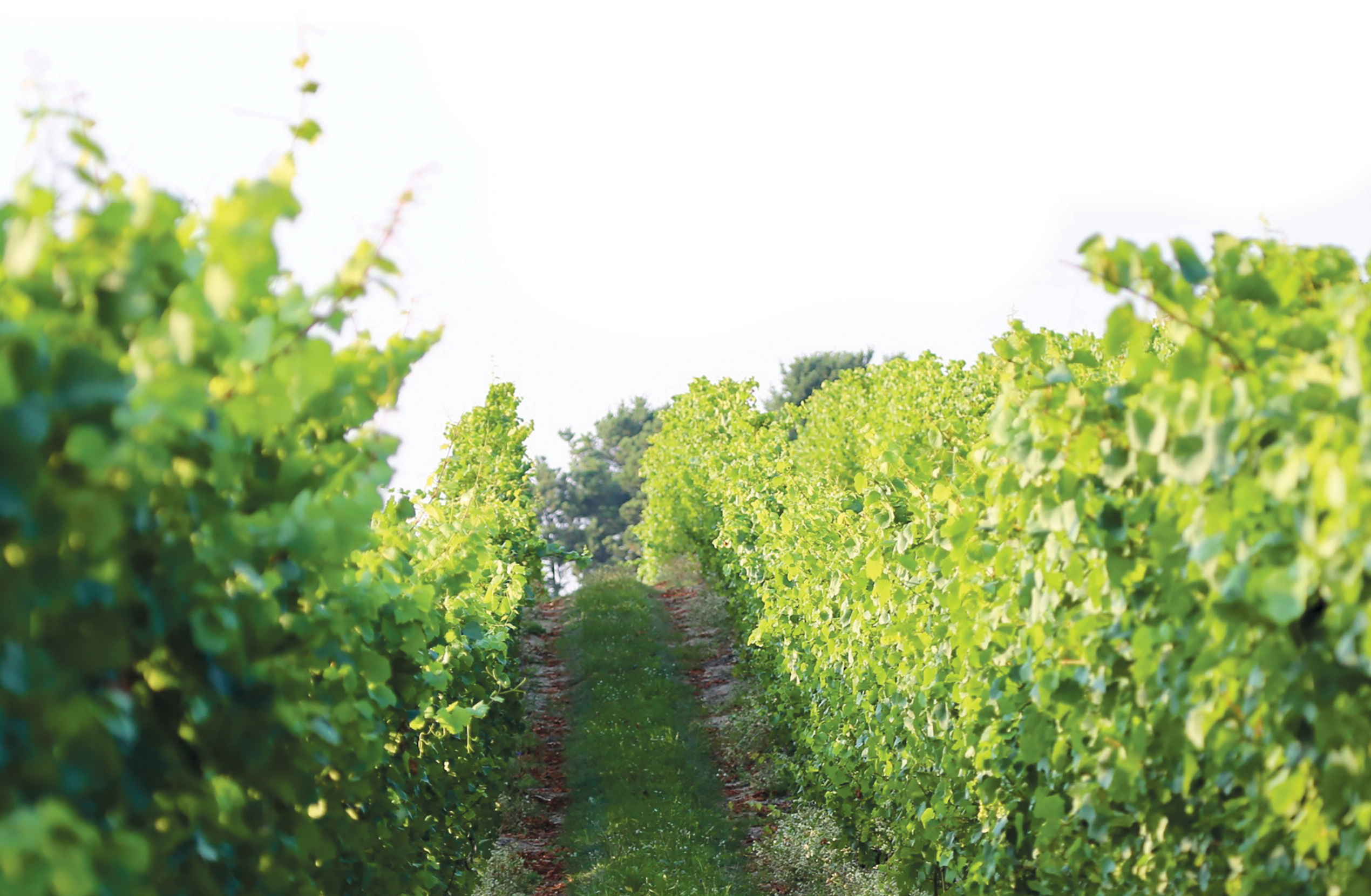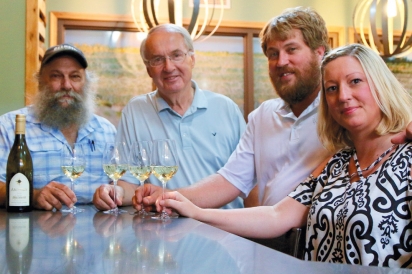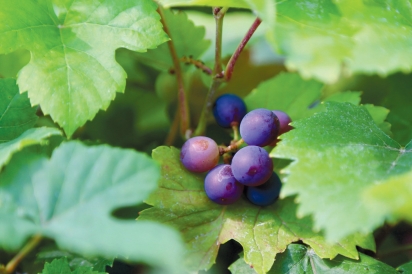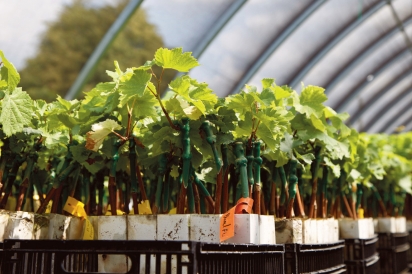Truly Michigan Vines
Truly Michigan Vines, the fruit of a meeting between a wine grower and a fourth-generation arborist, offers local options to Michigan vineyardists, be they established wineries or hobbyists.
About nine years ago, Kerm Campbell, proprietor of Black Star Farms vineyards and winery in Suttons Bay, Michigan, found himself on a plane to the West Coast seated beside a woman with a fascinating story to tell. She was employed by David Milarch, the leader of the Archangel Ancient Tree Archive, who had made it his life’s mission to clone what he calls champion trees—specimens that have survived and thrived for hundreds of years. He felt strongly that their genetic attributes were worth preserving through propagation.
Kerm shared with her that he grew grapes and would like to clone some of his best vines—those that were acclimatized to the Northern Michigan weather patterns, that year after year gave him the best grapes for his wines, and that were healthy and disease-free. Excited by the possibilities of a collaboration, as they deplaned in California, Kerm’s seatmate introduced him to David’s brother, Jake, sitting across the aisle, and they shared contact information.
Unfortunately, the original backer for the tree project nixed diversifying into vines and thus the idea was shelved during her tenure. She later withdrew from the Archangel Ancient Tree Archive, leaving the team behind the project without the funds to continue. When Kerm got wind of their situation he called up Jake, saying, “We need to talk.”
Jake brought his brother Jared over to take a look at the vineyard Kerm had in mind for the first cloning project, a parcel of 27- year-old Chardonnay grapes out by his home on Old Mission Peninsula. “These are the best Chardonnay vines east of the Mississippi. It’s amazing what fruit comes off them, and the vines are so healthy,” Kerm says. In the mid-winter chill, Jake and Jared cut bud wood from the dormant plants and brought it back to their nursery to clone.
That initial test produced 4,000 plants, which were grafted onto rootstock purchased from California (see root stock explanation below). Kerm had them planted on his Summit parcel off Center Highway in Leelanau Peninsula. The young vines surpassed expectations. Planted in 2012, they survived the harsh winters of 2013 and 2014, and from their third season have since been outproducing other Black Star parcels. The fruit, says Kerm, has been “marvelous!”
The project excited Jake from the start: to offer custom propagation of vines, with an emphasis on vines proven to grow well and produce healthy fruit in Michigan soils and climate. “It’s fun to be on the leading edge and to have a business partner with so much knowledge to offer,” says Jake. However, such a product is a difficult sell without solid research and history behind it. And so was born Campbell Milarch Vines in 2013. The initial R&D was conducted on Chardonnay and Gamay Noir varietals chosen from the healthiest, best- established and most interesting parcels at both Black Star Farms and Kerm Campbell’s personal vineyards. It has since been extended to include 15 different varieties from Vitis vinifera (the traditional European wine grape), including Pinot Gris, Riesling, Pinot Blanc, Cabernet Franc, Pinot Noir and Merlot, as well as the Marquette hybrid varietal.
The partners decided to plant and propagate rootstock as well, and thus offer an alternative to out-of-state-sourced rootstock for those interested in planting vines in Michigan. Hence the company name, “Truly Michigan Vines.” The vines are now available for sale out of the nursery’s Copemish greenhouses. The team also works with vineyards to provide custom grapevine propagation. Orders to date have ranged from the small (20–30 plants) to the large (10,000 plants). They plan to graft 25,000 next year, with the goal being to grow to 75,000–100,000 over the next few years.
Elaborating, Executive Director Amanda Milarch writes, “Before we entered the market, Michigan wineries were outsourcing propagation to California and New York.
The only option was also rootstock grown there. We are offering a Michigan rootstock, grown in Michigan soil.
“We also offer California rootstock if that is what they want. Each winery has very specific needs and we are trying to offer them a local option. In regards to soil needs, Sales Director Pat Murad, who has a horticulture background, reviews each customer’s prospective site to ensure the best outcome for the vines. We take orders into March and our goal is to have the vines ready to be planted June 1. We have done fall plantings as well, at the request of the winery.”
Jake sums up the project: “We want to offer better infrastructure and options to the out-of-state [grapevine] stock, and to eliminate what [pests] might come along in the shipping containers. It’s all about where the grapes come from. Walking through the vineyards, choosing the right vines for the right place and for consistency, the better the wine will be and the easier the vintner’s job.”
FOR THE FUTURE GRAPE GROWER: AN INTRODUCTION TO PROPAGATION CUTTINGS
Grape-growing dates back many thousands of years, as do propagating, grafting compatible plants and transporting them to new destinations. The ease of making cuttings, storing and rooting them, whether they be grafted onto rootstock or not, contributed to their migration beyond their original homes.
Clones are made via cuttings to reproduce good characteristics, such as disease resistance, aroma or flavor. It is the best way to preserve the desired characteristics of a grape variety.
Select cuttings when plants are dormant (mid-winter, pre-pruning); 1-year-old growth slightly larger than a pencil is optimal. Look for long, straight shoots from which you can cut 12- to 18-inch lengths with four buds. Identify/mark the top of the cutting to distinguish it from the bottom. Callus the cutting by exposing it to prolonged moist heat to help the cut base begin to heal and generate stem cell-like tissue that can develop into roots. You can then transplant to soil typical to your vineyard, putting three of the buds underground and the remaining one out of the soil.
Cuttings will exactly reproduce the top growth of a plant, however grapevines are often grafted plants whose rootstock from a different but compatible species gives the plant necessary resistance to threats such as pests, cold and drought.
IMPORTANCE OF ROOTSTOCK
As grapevine cuttings root relatively easily on their own, it wasn’t until a root pest outbreak nearly destroyed the European wine industry that grafting grape tops onto different bottoms became nearly universal. Phylloxera is a root louse native to the East Coast of the United States. Vines native to this region (think Concord grapes) are resistant to it, but the V. vinifera varietals (think classic wine grapes of Europe like Syrah, Cabernet and Chardonnay) are not.
The importation of Phylloxera to Europe via commercial cuttings wiped out the majority of the vineyards there, devastating wine production in the late 1800s. The industry was saved by the shipment of American rootstock to the vintners, who salvaged cuttings of their vinifera vineyards by grafting them onto the imported pest- resistant stock and replanting them. It is now standard in Europe and elsewhere for vineyards to be planted with grafted cuttings. Much work has gone into expanding the range of pest-resistant rootstock available, with expanded focus on adaptation to particular soil types, chemistry and fertility, as well as drought, excess water and/or salinity.
The rootstock clones traditionally used by Michigan wineries include the 3309 Couderc, the 101-14 Mgt, the SO4 and the Riparia Gloire de Montpellier, all of which were developed in Europe around the turn of the 20th century. To date, the primary suppliers are in California and New York.
According to the MSU Extension website, some of the work currently being done to improve the rootstock available to Michigan wineries is focusing on cold tolerance, particularly the rate and vigor of growth and canopy coverage, which are instrumental in supporting fruit maturity and avoiding cold injury.
For more information:
Campbell Milarch Vines
TrulyMIVines.com
Copemish, MI 248-535-2321








